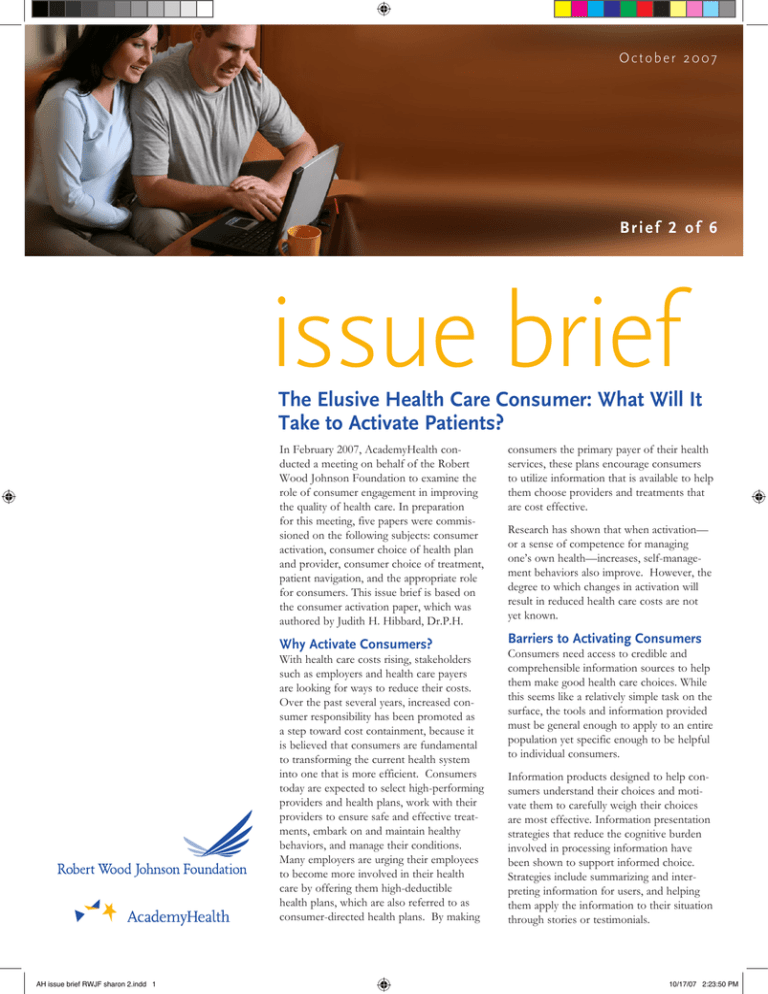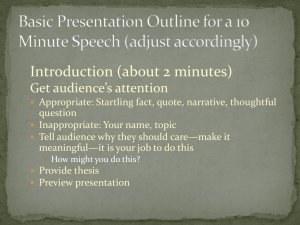issue brief The Elusive Health Care Consumer: What Will It
advertisement

October 2007 Brief 2 of 6 issue brief The Elusive Health Care Consumer: What Will It Take to Activate Patients? In February 2007, AcademyHealth conducted a meeting on behalf of the Robert Wood Johnson Foundation to examine the role of consumer engagement in improving the quality of health care. In preparation for this meeting, five papers were commissioned on the following subjects: consumer activation, consumer choice of health plan and provider, consumer choice of treatment, patient navigation, and the appropriate role for consumers. This issue brief is based on the consumer activation paper, which was authored by Judith H. Hibbard, Dr.P.H. consumers the primary payer of their health services, these plans encourage consumers to utilize information that is available to help them choose providers and treatments that are cost effective. Why Activate Consumers? Barriers to Activating Consumers With health care costs rising, stakeholders such as employers and health care payers are looking for ways to reduce their costs. Over the past several years, increased consumer responsibility has been promoted as a step toward cost containment, because it is believed that consumers are fundamental to transforming the current health system into one that is more efficient. Consumers today are expected to select high-performing providers and health plans, work with their providers to ensure safe and effective treatments, embark on and maintain healthy behaviors, and manage their conditions. Many employers are urging their employees to become more involved in their health care by offering them high-deductible health plans, which are also referred to as consumer-directed health plans. By making AH issue brief RWJF sharon 2.indd 1 Research has shown that when activation— or a sense of competence for managing one’s own health—increases, self-management behaviors also improve. However, the degree to which changes in activation will result in reduced health care costs are not yet known. Consumers need access to credible and comprehensible information sources to help them make good health care choices. While this seems like a relatively simple task on the surface, the tools and information provided must be general enough to apply to an entire population yet specific enough to be helpful to individual consumers. Information products designed to help consumers understand their choices and motivate them to carefully weigh their choices are most effective. Information presentation strategies that reduce the cognitive burden involved in processing information have been shown to support informed choice. Strategies include summarizing and interpreting information for users, and helping them apply the information to their situation through stories or testimonials. 10/17/07 2:23:50 PM issue brief — The Elusive Health Care Consumer: What Will It Take to Activate Patients? While information is necessary, it is often not sufficient to stimulate and sustain behavioral adoption. There are a variety of reasons why this may be true. Behavioral adoption depends on the degree to which individuals believe that the behaviors will result in outcomes they personally value and whether they feel competent to do the behaviors. It may also depend on the degree to which the individual perceives that others view the behavior as appropriate and accepted. For example, when patients are not encouraged by their providers to take an active role in their health, the implicit message is that being passive is appropriate and acceptable. Changing health behaviors is not easy. They are often life-long habits, and they can be embedded in the social, physical and cultural context in which people live their lives. Patient Activation Measure The Patient Activation Measure (PAM) evaluates consumer knowledge, skill and confidence for self-managing health and health care. The PAM has been shown to predict behaviors ranging from diet and exercise to disease self-management and utilizing health information. Four levels of activation have been identified. Understanding the activation levels of consumers can help in developing strategies for increasing activation and self-management. The four levels are: • Level 1—Does not yet grasp the need to play an active role in personal health • Level 2—Lacks knowledge and confidence to act • Level 3—Is beginning to take action • Level 4—Has adopted new behaviors but may not be able to maintain them under stress These levels of activation provide insight into possible strategies for supporting consumers who are at different points along the continuum. Findings from a longitudinal study indicate that activation is changeable. It found that increases in activation were accompanied by improvement in 11 of 18 health behaviors. Research findings on activation suggest that activation is an outcome in itself, and strategies should be designed that explicitly seek to increase activation levels. AH issue brief RWJF sharon 2.indd 2 How to Activate Consumers The most promising approaches to supporting patient activation are those that are participatory rather than didactic, involve family members and use multiple approaches. Strategies that tend to support self-regulation—being observant, making judgments based on observation, and setting and seeking personal behavioral goals—are the most successful. While not yet tested, it is hypothesized that interventions tailored to the individual’s level of activation will yield good results. Many patients have had years of experience with failure, as they have been unable to make needed changes in their lives. They feel disempowered and have little confidence in their ability to make changes. People gain a sense of self-efficacy by experiencing success. If patients are asked to take small steps that are realistic given their level of activation, they have a greater chance to experience success and build confidence for meeting their next challenge. Segmenting consumers into groups to increase activation could also prove beneficial, especially if the segmentation accounts for clinical risk factors. It would allow health care providers to customize their strategies to address the specific challenges associated with each level of patient activation. If implemented before risks increase or health worsens, patients could require less acute care as their self-management skills improve and they gain confidence. Similar techniques can be used by other stakeholders, such as providers and employers. Providers, for example, can utilize patient registries in combination with the PAM to identify and educate specific populations, helping to improve quality and outcomes for their patients. Together, insurers, providers and employers can help improve patient activation by addressing the specific challenges consumers face as they begin to manage their health. Community-level interventions can also be advantageous in motivating consumers to become active in their health care. For example, when implementing its Part D prescription drug plan, the Centers for Medicare and Medicaid Services (CMS) utilized community organizations and targeted community outreach to motivate beneficiaries to sign up for a plan. In a page 2 similar way, outreach at the community level could help provide the local momentum to activate a specific population. Highly activated consumers are more likely to use information resources such as report cards. Reaching out to those who are more activated to become role models and opinion leaders may help to hasten change in the community. Next Steps The current approach of increasing the financial burden on consumers is unlikely to result in greater consumer activation. Supporting activation will likely require meeting consumers where they are, which implies moving from a generalized approach to an individualized approach. As long as we continue to use a one-size-fits-all approach, we are likely to see little response from patient and consumer audiences. As noted earlier, it is important to recognize that consumers are unable to make these changes on their own and engaging the entire health system will be necessary. An essential task in this process is empowering providers to understand the various levels of activation and how to individually tailor messages and support for their patients so as to make the biggest impact. Research has not yet determined whether increasing consumer activation will improve overall health outcomes, either individually or generally. However, it is also important to understand what types of interventions have the greatest effect on outcomes, how various interventions impact consumers at each level of activation and in the general population, and how populations with low literacy or without health insurance—which tend to have lower health status—can be activated. Financial incentives are commonly used to motivate specific consumer behaviors. It is not clear, however, who is responding to these incentives. Do those who are more activated take advantage of them? Even more important is whether responding to incentives ultimately leads to sustained behavior change and increased activation. In a system that is moving towards paying providers based on quality while also motivating consumers to become more active in their health care, it is important to understand how incentives aimed at each group can affect the other. 10/17/07 2:23:50 PM issue brief — The Elusive Health Care Consumer: What Will It Take to Activate Patients? Conclusion Improving the quality of health care will take efforts from all stakeholders, including consumers. Engaging consumers to become active participants in their health care is an important element of making this AH issue brief RWJF sharon 2.indd 3 transformation. However, consumers will not make the necessary changes without supports. This means that the health care system must move away from the current delivery-centered model and toward one that is patient centered. Movement in this direction will help support increased page 3 patient engagement and align the health care industry with that of other sectors. About the author Cyanne Demchak is a research assistant with AcademyHealth. 10/17/07 2:23:51 PM


